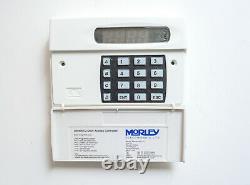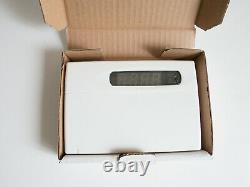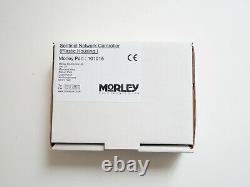
- Index
- Communication
- Features
- Access Control Board (2)
- Add-on Camera (5)
- Battery Backup (3)
- Bluetooth (3)
- Bracket (7)
- Commercial (2)
- Control Door (4)
- Digital (2)
- Durable (12)
- Easy To Install (2)
- Electronic (4)
- Fingerprint (4)
- Flashing Led (7)
- Free Application (2)
- Ip Intercom (8)
- Regular (26)
- Universal (2)
- Wall Mounted (6)
- Waterproof (9)
- Wi-fi (10)
- Other (2209)
- Finish
- Item Height
- Item Width
- Style
Morley Sentinel Door Access Network Controller 101015





Simple programming: Morley Electronics Sentinel controller. What our experts say With the sentinel access controller the simplest to program we have ever come across as the basic building brick, the design and installation of an access control system should be a straightforward task. The controller is available either in an intruder alarm sized remote keypad enclosure, or housed in a large steel box with built-in power supply, standby battery space and tamper arrangements. We looked at the large steel box version.
The Sentinel two-door access controller can be used as a standalone unit or networked with up to 15 additional controllers to provide a 32-door system. Flexibility is the name of the game along with ease of installation, programming and user friendliness. PC control is not necessary, but can be used for operational convenience. When used in the standalone mode for a two-door system, the non-networkable controller is considerably cheaper than the networkable ver-sion, resulting in a very economical access solution. The Sentinel controller can support a wide range of proximity readers using either PAC format or Morley format.
A system will follow the format configured in the master controller both formats cannot be used simultaneously. The system, irrespective of the number of controllers used, supports up to 4000 individually identifiable tokens or cards. Each controller has four input terminals for connection to egress (exit) button contacts, door monitor contacts or global fire input contacts. The egress button and door monitor inputs can be programmed for use with either NO or NC contacts. The fire input, obtained from a single pair of NC contacts for fail safe operation, releases all the system doors.The Sentinel controller has four output relays, each having a single pair of clean (volt-free) contacts, rated at 1A, 120v AC/24v DC. These can be configured NO or NC for controlling door release mechanisms (strikes), giving the option of fail safe or fail secure operation, also for door alarm outputs. All events are time stamped and colour coded. Card addition can be carried out either with the aid of a master card at reader 1 or by entering the card identification number at the controller keypad when Morley format readers are used.
PAC format cards have no identification numbers printed on them and can only be added at reader 1 with the aid of the master card. Card deletion follows a similar pattern. PAC format cards are each assigned a slot number during addition so that lost or stolen cards can be deleted by entering the slot number at the controller keypad. The access of each user can be restricted by setting up access profiles and selecting the appropriate profile before adding the card to the system. A maximum of eight profiles can be configured. It sounds a bit cumbersome but a profile can be selected by entering a single digit, rather than having to go through every reader on each occasion of adding cards or changing their access profile. Automatic door override can be programmed for each door on the system on a five or seven day basis, allowing free access for one defined period for each reader on the system. When networked, user cards can be added at any controller and immediately used at any reader within the access profile selected.When further Sentinel controllers are added to an existing system, the card database is automatically synchronised absolutely painless. Should a complete power down occur, the pro-grammed and stored card information is held by an on-board NiMH (nickel metal hydride) battery. NiMH batteries are beginning to replace NiCads. The Sentinel controller, housed in a large 1 mm steel box containing the control PCB 135 mm x 93, 12 v PSU PCB 84mm x 98, mains transformer, mains fused connector and tamper switches.
There is more than adequate space available for a 7 Ah 12v stand-by battery. The layout of components is sensible with the heat producers mains transformer and PSU mounted at the top of the enclosure. Both PCBs are mounted on the lid of the enclosure; the control PCB being used to sandwich the key membrane in place. Key action is positive, backed up with an on-board bleeper.
Quality of PCB construction is of the high standard generally seen in security equipment, resulting in reliable operation. Suppression is necessary Installation of the steel boxed version of the Sentinel is made easier by the provision of an on-board 12v DC power supply with spare capacity which can be used to power the door strikes.The PSU in our sample was fused at 1A so that since the controller and readers require a maximum of 250mA, this leaves 750mA spare. The installer will need to check this with the door strikes used one sample we have looked at in the past needed 490mA! Morley Electronics makes the point that suitable suppression must be used. This requirement can not be overstressed if a diode is connected, in reverse, across the door release, it will blow on first time switch-on (a bit like a fuse), but will probably go unnoticed.
Induced voltage spikes, which occur when switching off, will not be suppressed, leading to early failure of the coil/relay contacts/equipment connected to the same supply. The cable required for connecting readers depends on the type of reader used. Normal alarm cable for PAC format readers; screened core cable for Morley format readers.
Maximum permissible cable length for either type is 125m. When Sentinel controllers are networked a daisy chain two-wire connection method is used up to a maximum length of 1km. The network must be correctly terminated by inserting an activating link in the first and last controllers.
The User and Installation Manual supplied with the equipment is a very succinct document. It starts with a concise, informative introduction, followed by the Programming (User) section, finishing with the Installation section. A sensible order since the User does not have to thumb through the installation pages to get to his bit. The programming instructions are clear and well supported by pictorial examples showing keystroke inputs and the resulting Sentinel controller displays.
We slowed down when we came to access profiles largely because we were expected to select one before they had been configured. The revised version of the manual, written to include the steel boxed version of the Sentinel, helped to clear the confusion. The installation instructions are clear with good accompanying diagrams.We consider that the following need to be added. A list of technical specification figures for ease of reference. An annotated controller PCB layout diagram. A diagram showing door release suppressor components fitted in order to stress their importance. These additions will make a basically sound manual more installer friendly.
Installers additionally wanted an easy to install and commission system, which minimised setting up time. The product range designed to meet these market needs is Sentinel.
Each two-door controller operates as a stand-alone system, offering 4,000 users and using any proximity reader and token from the HID range, including smart and biometric readers. Vandal and panel mount HID technology readers will be available imminently. Sentinel controllers have four contact inputs and four 1A relay outputs, each programmable.
Sentinel programming is via a backlit keypad, which also doubles as a real time clock display, and each Sentinel has a 4,000-event log and laser/inkjet printer output for report printing. Housing options are an intruder keypad or ruggedised lockable enclosure complete with PSU. Up to 16 standalone Sentinels can be networked to form a 32-door system with or without PC control.
No additional parts are necessary other than the inter- connecting cable. Network cabling is a twisted pair, daisy chained to a maximum network length of 1km. Programming the network is very simply executed via the Sentinel keypad. In a network, users can be added to any controller and will be automatically updated to other controllers. The item "Morley Sentinel Door Access Network Controller 101015" is in sale since Wednesday, September 2, 2020. This item is in the category "Business, Office & Industrial\Facility Maintenance & Safety\Access Control Equipment\Other Access Control Equipment". The seller is "nails-star" and is located in London.This item can be shipped to United Kingdom.
- MPN: 101015
- Brand: Sentinel

